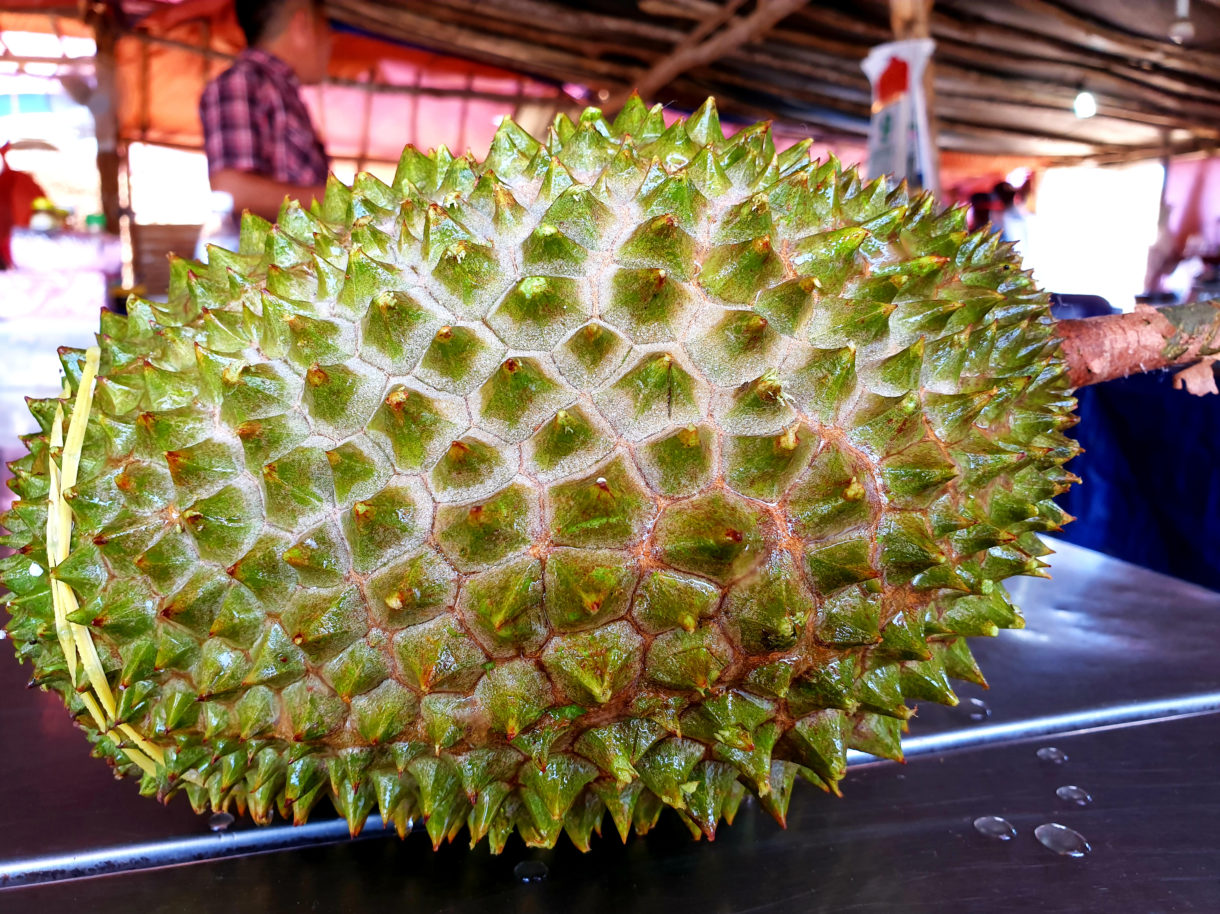The durian, for those of you who’ve never seen one, is a Southeast Asian fruit that looks like a fiercely weaponized pineapple. It’s prickly. It’s pricey. And it’s oh so pungent. And you will never forget your first whiff, says Zamzani Abdul Wahab — the Malaysian celebrity chef better known as Chef Zam — who remembers the first time two of his foreign friends got theirs when they visited him in Kuala Lumpur a few years back.
“They almost died, and I had to call an ambulance on them,” he says, laughing. He may be exaggerating — but just a little. Last month, more than 500 people were evacuated from a library in Australia after a gas leak scare that turned out to be … yup, a rotting durian left in a trash bin.
“Julia Child once said that it smells like dead babies mixed with strawberries mixed with Camembert,” Chef Zam says. “You have to bear in mind, they’re an acquired taste.”
Here in Southeast Asia, you may not bring durians on trains, planes or in taxis. And don’t even think about sneaking one into your hotel room. But here’s the thing: Once you get past the smell, they’re delicious. And the Chinese in particular have fallen hard for the pungent fruit in the past few years, putting it in everything from pizza to ice cream, even cakes. And, says Chef Zam, the Chinese have fallen even harder for what’s widely considered Malaysia’s best variety of durian, the Musang King.
“In Chinese it’s called Mao Shan Wang. In Malay it’s called Musang King,” he says. “And it’s the best because … the color is golden yellow, the flesh is sweet with a slight bitterness at the end that makes it the most special one, the most special breed of all.”
The Thais might beg to differ. After all, they currently supply the vast majority of durians consumed in China and a staggering 90 percent of durian exports worldwide. Thailand is the only country currently allowed to export whole durian to China. For now, Chinese import regulations mean Malaysia can only ship frozen bits and pulp, not the whole fruit. But in a few months, China will begin allowing whole Malaysian durians, too. Game on, Thailand.
“This is going to be a game changer,” says Sim Txe Tzin, Malaysia’s deputy minister of agriculture. And he’s not above throwing a little shade at his Thai neighbors.
“For Malaysia durian, we are selling quality, OK?” he says. “For Thai, they are selling quantity. It’s just like Thais are selling beer, we are selling champagne. Good quality champagne.”
The Malaysian government wants to make durians one of the country’s leading exports. And with the Chinese appetite for the spiky fruit showing no sign of easing, there’s a whole passel of people looking to cash in on the Durian Gold Rush.
“It’s a huge capital investment, but the reward is promising,” says Ng Lee Chin, the chief executive officer of the M7 Plantation Berhad — one of the newest and biggest operators in the fast-growing market. I traveled with her to the company’s new durian plantation, a former logging concession in a forest in Gua Musang, Kalantan, which gives the Musang King its name.
“At the moment, we have planted 300 acres with Musang King durian trees,” she says.
That’s 15,000 trees so far — with a goal of some 150,000 trees over 3,000 acres — which would make the company one of the biggest, if not the biggest, producers in the country. It’s a high-tech operation, complete with surveillance cameras that monitor every single tree, as well as other state-of-the-art technology to closely monitor the progress of the notoriously temperamental Musang King as it ripens.
“Each of the trees [has] their individual sprinkler that [supplies] water to them consistently,” Chinsays. “And we fertilize it every two weeks. And we do have consultants that come in and advise us on the condition of the tree and the growth of the tree.”
“They’re my babies,” she says. And when those babies start bearing fruit, each single durian could fetch more than $100 once it makes it to China. The company also welcomes Chinese investors.
But not everyone is as enthusiastic about the durian craze — especially environmentalists who’ve seen what palm oil and rubber have done to Malaysia’s forests and biodiversity.
“So far, I haven’t seen thousands and thousands of hectares being opened up specifically for durian,” says forest researcher Lim Tek Win. “But I can see it’s certainly on the horizon, when people are talking about how much money they can make from the durian, that the temptation will be to open up very large areas — and specifically in [largely untouched,] natural forest.”
And if that happens, he says, the results could be catastrophic for the forests’ biodiversity. It could result in a loss of habitat for elephants, tigers and sun bears, he says, and the loss of thousands of different plant species. “Unless there are more controls being put in place and the government comes up with a clear policy as to whether or not such plantations are allowed inside [protected] Forest Reserves, then it is a danger,” he says.
Deputy Agriculture Minister Sim Txe Tzin insists that won’t happen. In fact, he says that small-scale farmers will benefit too, by making more money selling durian than palm oil or rubber. And Chinese consumers will obviously be happy as well.
But the Thais, long accustomed to being the export kings of what Southeast Asians refer to as the King of Fruits? Maybe not so much.
9(MDEwNzczMDA2MDEzNTg3ODA1MTAzZjYxNg004))
